
What Does Your Cat’s Silent Meow Mean?
Cats are known for their mysterious and often elusive behaviors, with their ways of communicating being just as enigmatic. Among the various vocalizations cats make, the silent meow is particularly intriguing. It’s a quiet gesture where a cat opens their mouth but emits no sound that’s audible to the human ear. This subtle form of communication can be easily missed but is significant in the world of feline interaction, expressing a range of emotions and desires.
Understanding the silent meow is essential for cat parents eager to enhance their bond with their feline companions. Cats use this silent signal in various scenarios, from a silent greeting to a polite request for attention or food. By observing our cats’ silent meows and the contexts in which they occur, cat parents can gage their cats’ feelings and well-being. Recognizing and responding to this quiet call can bolster the relationship between humans and cats, creating a deeper sense of understanding and trust.
Key Takeaways
- The silent meow is a quiet but important way cats communicate with humans and other cats.
- Observing and understanding the context of silent meows can help cat guardians connect with their cats.
- Responding to silent meows can improve the human-cat relationship and indicate awareness of a cat’s needs and emotions.
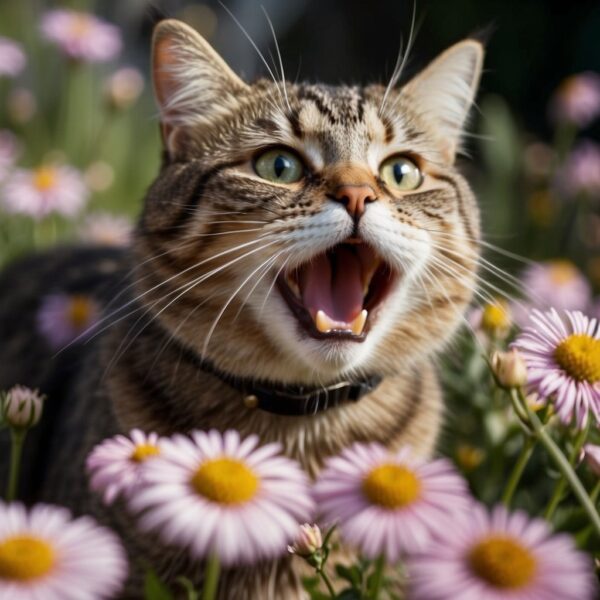
Understanding the Silent Meow
Silent Meows often carry significant meanings and vary in context, from a cat’s attempt at communicating for attention to expressions of affection.
The Science Behind Silent Meows
Silent meows involve a cat opening its mouth, yet no sound is heard by human ears. This phenomenon is a type of vocalization that falls outside the audible range for humans, but it may carry frequencies that other cats or animals can detect. Cats possess a broad vocal range, and they utilize different parts of it to communicate various needs or emotions. In a silent meow, the cat’s vocal cords move as if to meow, suggesting that the act is intentional.
Key Aspects:
- Intentional Movement: Cats deliberately move their vocal cords during a silent meow.
- Inaudible Frequencies: Silent meows may be within a frequency undetectable to humans but perceptible to other animals.
- Communication Tool: They’re an important tool for cats to express themselves, even if silently.
Comparing Silent and Vocal Meows
Vocal Meows are typically a cat’s way to get attention, express hunger, discomfort, or a desire for affection. They can range from high-pitched and urgent to low and prolonged. In contrast, Silent Meows may be similar in intent but differ in execution and perception.
- Silent Meows:
- Might be a subtle plea for attention
- Could display quiet affection
- Often occur in a calm, non-threatening context
- Vocal Meows:
- Are more easily noticed by humans
- Can indicate a more immediate or desperate need
- Range in volume and tone to convey different messages
Cats are clever in using various forms of meows to communicate with their human companions, adapting their signals to what they believe is most effective in getting a response.
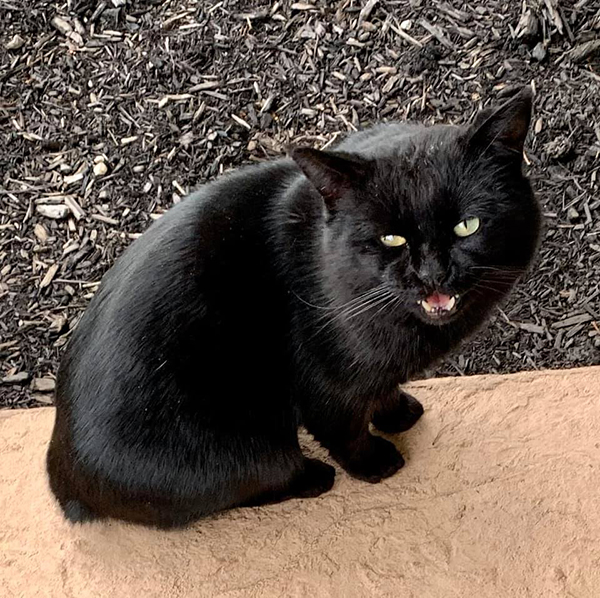
The Role of Silent Meows in Feline Communication
Cats use a variety of vocalizations to express their needs and emotions, with the silent meow being one of the more intriguing methods. This muted form of communication relies heavily on visual cues and has been shaped by the cat’s domestication.
Interpreting a Cat’s Silent Meow
When a cat emits a silent meow, its mouth may open as if to meow, but no sound is heard. To understand this subtle behavior, it’s important to consider the cat’s body language and environment. Eye contact and facial expressions accompany the silent meow and can be indicative of the cat’s intent.
- Trust and Affection: A silent meow directed at a human often signifies trust and a desire for attention or food.
- Pleading Gesture: Without vocal sound, the silent meow can be a polite way of asking for something, displaying less urgency than vocal meows.
A cat’s communication is complex, and silent meows often require humans to be more attentive to the silent language of stance, gaze, and facial movement.
The Impact of Domestication on Cat Vocalizations
Cats have evolved to communicate with humans in unique ways due to their close relationship with people. The silent meow is potentially a result of this domestication process.
- Human Interaction: Cats have learned to use silent meows as a less disruptive method to gain attention, understanding that humans rely more on visual cues than other cats might.
- Selective Breeding: As certain traits are favored in domestic cats, so too might quieter forms of communication be reinforced over generations.
The silent meow exemplifies how cats have adjusted their communication methods to coexist more harmoniously with humans, utilizing a balance of sound and silence to convey their messages.
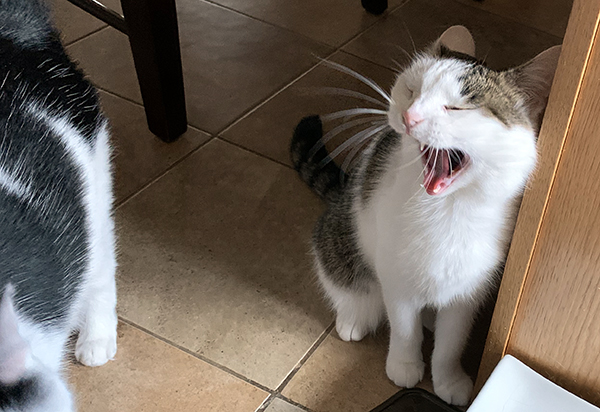
Behavioral and Emotional Aspects
Cats communicate through various behaviors and vocalizations, each carrying emotional significance. They form strong bonds with humans, often expressing their feelings through nuanced actions like the silent meow.
Health and Emotional Meaning
When a cat attempts a meow without sound, known as a silent meow, it can be a sign of emotional expression or a health issue. Silent meows may reflect a cat’s emotional state such as comfort, discomfort, or gratitude, depending on the context in which they occur. For instance, a silent meow paired with a relaxed body might indicate the cat feels secure and content. In contrast, if a cat is visibly tense or there are changes in its eating habits, the silent meow could signal that it’s feeling unwell or hungry. Identifying the silent meow’s underlying cause, whether it be emotional or health-related, is critical.
- Emotions: A silent meow can convey a variety of emotions. Context is key in interpreting what a cat may be feeling.
- Comfort: Might be lying down, eyes half-closed
- Discomfort: Signs of restlessness or avoidance behaviors
- Gratitude: May occur after being fed or petted
- Health Concerns: A cat that is silent due to physical discomfort might show symptoms like:
- Reduced appetite or avoidance of food
- Changes in sleeping patterns, perhaps indicative of being sleepy from illness
Attachment and Affection Expression
Cats often use the silent meow as a subtle form of bonding and expressing affection. This behavior is more commonly directed towards humans with whom they have a close relationship. The silent meow serves as a private communication, indicative that the cat trusts and values the presence of the person. Additionally, the silent meow can be an appeal for attention, reaffirming their emotional connection to their human companions.
- Expressing Attachment:
- Close proximity: Often coupled with rubbing against the person
- Purring: A sign of contentment when near their favored human
- Seeking Interaction:
- Gentle nudging with their head or paw
- Soft blinks conveying trust and fondness
Understanding these behavioral and emotional aspects surrounding the silent meow enriches the human-cat relationship, allowing cat parents to better address their cat’s needs and emotions.
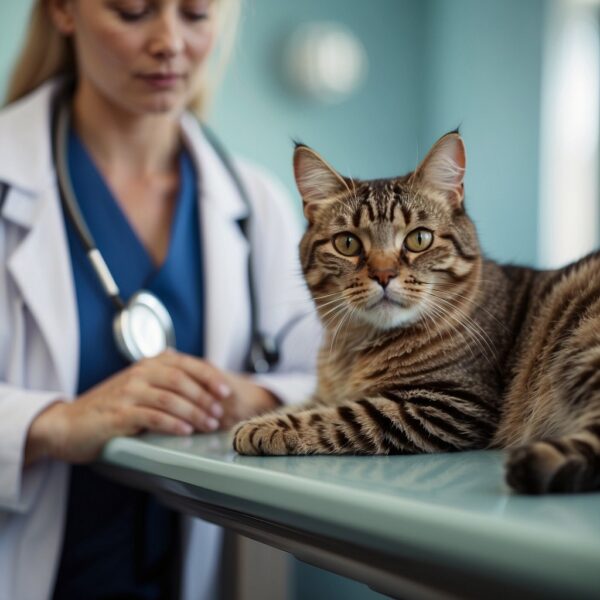
Health Implications of Cat Meows
Changes in a cat’s meowing can be a signal of health issues. Recognizing these vocal cues is important for addressing potential medical problems.
Identifying Medical Issues Through Vocalizations
Cats typically communicate through a variety of vocalizations, including meowing. Deviations from a cat’s normal vocal patterns can indicate that the cat may be experiencing a health problem. A silent meow, one where the cat opens its mouth but no sound emerges, might seem cute but can sometimes point to an issue with their vocal cords or respiratory system.
The pitch, volume, and frequency of a cat’s meow can provide clues to their well-being. A persistent increase in these vocal behaviors often signifies that the cat is in distress or discomfort. For instance:
- Persistent loud meowing may be a sign of thyroid problems or high blood pressure, particularly in older cats.
- A sudden change in voice can suggest a throat issue or an infection.
Regular observation and noting any changes in a cat’s meow is important for maintaining their health.
When to Seek Veterinary Help
It is recommended that cat parents seek veterinary advice if they observe any unusual changes in their cat’s meowing patterns. Signs that warrant vet attention include:
- No sound: A silent meow that occurs frequently.
- Intense vocalization: Loud or frequent meowing that’s unusual for the cat.
- Loss of voice: If the cat’s meow becomes hoarse or absent.
A veterinarian can assess these vocal changes and rule out health conditions such as respiratory problems, infections, or other illnesses. Here is a simple reference for cat parents:
| Vocal Change | Possible Health Issue |
|---|---|
| Silent Meow | Respiratory or vocal cord issue |
| Loud Meowing | Thyroid or blood pressure issues |
| Hoarse Voice | Infection or throat problems |
An examination by the vet often includes a physical check-up, and sometimes further tests, to find the cause of the vocal changes. Detecting illness early can improve the chances of successful treatments, ensuring better health outcomes for the cat.
The Science and Research on Cat Meows
Cats communicate with humans using a range of vocalizations, with the meow being particularly studied for its acoustical qualities and its role in cat-human interactions.
Studies on Cat-Human Communication
Researchers have dedicated time to understanding how domestic cats use meows to communicate with people. One prominent researcher in this field is Nicholas Nicastro, from Cornell University. His work asserts that cats may have adapted their vocal signals to better communicate with humans. Studies indicate that domestic cats, unlike their wild counterparts, often use the meow specifically to engage with people. This vocalization can vary significantly based on the cat’s needs or emotional states.
Understanding Feline Vocal Behavior
To dive into the acoustical qualities of cat vocalizations, researchers record and analyze these sounds. The analysis includes the evaluation of pitch, loudness, and duration of various types of meows. Some meows are loud and attention-grabbing, while others might be soft, such as in the case of the silent meow.
Acoustical research helps to decipher the nuances of cat vocal behavior and its impact on human-animal interaction. By using objective measures like frequency analysis, researchers gain a deeper understanding of the complex vocal system of cats. The intention is to improve our comprehension of cats, fostering better and happier relationships with these popular pets.

Variations in Cat Breeds and Meowing
Different cat breeds exhibit unique vocalization patterns, and the silent meow is a fascinating behavior observed across various breeds.
Breed-Specific Vocalization Patterns
Certain cat breeds are known for their distinctive meows and vocal signals. The Siamese cat, for instance, is famous for its loud and persistent meowing. Its vocalizations are not just louder but often longer in duration, which can indicate their need for attention or express discomfort. The Abyssinian breed tends to be vocal as well, with a softer meow used for social interaction.
Russian Blues display a more reserved vocal behavior. These cats usually vocalize less frequently, and when they do, their meows tend to be softer and more subtle. This breed may rely more on body language and less on vocalization to communicate.
Silent Meow Instances Across Breeds
The silent meow is an intriguing phenomenon where a cat appears to meow, but no sound is heard. It can be seen across various breeds and is not limited to a specific type. It involves the mouth movement of a meow without the vocalization. It’s essential to understand that this behavior is a normal part of a cat’s communication. The reasons behind a silent meow can vary; it might be a quiet plea for attention or an understated greeting.
Parents of cats from different breeds, including the ones mentioned, may at times observe the silent meow. It isn’t breed-specific and can convey a range of emotions and intents, from affection and greeting to a subtle request for something. The silent meow’s meaning often depends on the context and the individual cat’s personality and habits.
Enhancing Human-Cat Relationships
Improving the bond between cats and their human parents involves recognizing and responding to various communicative signals, including those that are hard to notice, like the silent meow.
Improving Communication with Your Cat
To foster a strong relationship with a cat, it is important to understand their means of communication. Cats use a variety of signals such as body language, vocalization, and behavior to express their needs and emotions. Human parents can enhance their bond by:
- Observing body language: Tail position, ear orientation, and whisker placement can reveal how a cat is feeling.
- Recognizing vocal cues: While meows are common, cats also use chirps and purrs to communicate.
- Paying attention to behavior: Actions like scratching and kneading are often used to seek attention or express comfort.
By becoming attentive to these nuances, humans can improve their interactions and show their cats the attention they seek.
Responding to Your Cat’s Silent Meow
A cat’s silent meow may be a subtle, attention-seeking action directed specifically towards their human parents. It’s a quiet open-and-close motion of the mouth that can indicate a variety of needs or feelings. Here is how cat parents can respond thoughtfully:
- Provide immediate attention: Acknowledge the silent meow promptly to show understanding and strengthen bonding.
- Assess their environment: Check for any needs like food, water, or a clean litter box.
- Consider health and well-being: A silent meow might also be a sign of discomfort or a health concern that requires a vet’s attention.
By tuning in to these silent signals, human parents can convey their care and enhance their relationship with their feline companions.
Advice and Tips for Cat PARENTs
Cat parents can enhance their relationship with their feline companions by accurately interpreting their meows and ensuring their environment promotes wellbeing.
Practical Ways to Interpret Meows
Cats communicate with their guardians through various types of meows, each with its unique meaning. Silent meows, where a cat opens its mouth but no sound comes out, are particularly intriguing. They might be seeking attention or indicating a polite request. A cat that meows insistently at the dinner table could be begging for food or signaling that it’s time for their meal. It’s beneficial for parents to recognize these meow patterns:
- Hunger Meows: Often persistent and loud, indicating they expect food.
- Attention-Seeking Meows: Lighter meows used to initiate petting or play.
- Silent Meows: An intimate gesture for attention or a subtle plea.
Creating a Comfortable Environment
A content cat is typically a healthy cat, and their environment plays a significant role in this. Parents should provide a space that caters not only to their basic needs like food and water, but also to their mental and physical stimulation. Here’s how to achieve this:
Basic Necessities:
| Necessity | Details |
|---|---|
| Food | Offer a balanced diet with precise meal times. |
| Water | Keep fresh water available at all times, possibly with a running water fountain. |
Safe Spaces:
- Resting Areas: Ensure there are cozy spots for napping, away from the hustle and bustle.
- Hiding Places: Cats need places to retreat and feel secure, like a box or a dedicated cat house.
Stimulation:
- Toys: Provide a variety of toys to keep them physically active and mentally engaged.
- Vertical Space: Cats love to climb, so cat trees or wall shelves can enrich their environment.
Parents should remember that each cat is an individual with their own personality and preferences. It’s important to pay attention to how their cat responds to different environmental factors and adjust accordingly. The true language of care lies in observing and understanding these preferences.
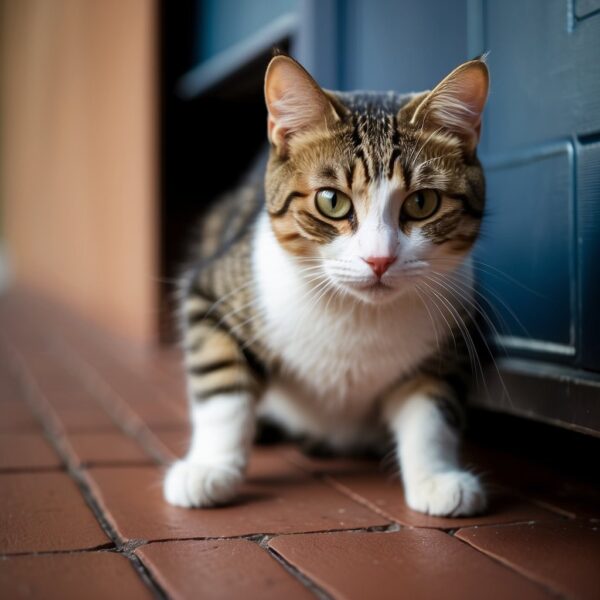
Frequently Asked Questions
Cats communicate in a variety of ways, and understanding the nuances of their meows can provide insight into their needs and emotions.
Why does my cat attempt to meow without any sound?
A silent meow can be a normal behavior for cats when they are content or seeking attention. They may open their mouth as if to meow, but no sound comes out. This behavior is often directed towards humans and may be a cat’s way of communicating without being disruptive.
Is a cat’s silent meow an indication of illness?
While a silent meow can be typical behavior, if a cat is consistently silent when attempting to meow, it could indicate a respiratory issue or sore throat. If there are other symptoms present, or if the silent meow is a change from usual vocal behavior, it is advisable to consult a veterinarian.
What are the different meanings behind various cat meow sounds?
Cats use meows to express a range of needs and feelings. High-pitched meows may signify happiness or a request for attention, while deeper meows might communicate discomfort or annoyance. Continuous meowing could indicate that your cat wants something, like food or to be let outside.
What could a low-pitched meow suggest about a cat’s needs or feelings?
A low-pitched meow might indicate that a cat is annoyed, upset, or feeling aggressive. Paying attention to the context and other cues such as body language can help in understanding why a cat is producing a low-pitched meow.
When a kitten exhibits a silent meow, what might this behavior imply?
Kittens may display a silent meow when they are learning to vocalize or trying to get attention without prompting a strong reaction from their mother. It’s also a sign that the kitten feels safe and is requesting gentle interaction.
How can I interpret my cat’s whisper-like meow?
A whisper-like meow, which is typically softer than a normal meow, can indicate that your cat is being affectionate or may not want to disturb you. They often use this soft meow when they are content and in a relaxed environment.